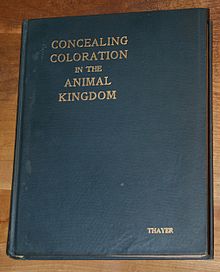 Cover of first edition | |
| Author | Gerald H. Thayer |
|---|---|
| Illustrator |
|
| Subject | Camouflage |
| Genre | Natural history |
| Publisher | Macmillan |
Publication date | 1909 |
| Publication place | US |
Concealing-Coloration in the Animal Kingdom: An Exposition of the Laws of Disguise Through Color and Pattern; Being a Summary of Abbott H. Thayer's Discoveries is a book published ostensibly by Gerald H. Thayer in 1909, and revised in 1918, but in fact a collaboration with and completion of his father Abbott Handerson Thayer's major work.
The book, illustrated artistically by Abbott Thayer, sets out the controversial thesis that all animal coloration has the evolutionary purpose of camouflage. Thayer rejected Charles Darwin's theory of sexual selection, arguing in words and paintings that even such conspicuous animal features as the peacock's tail or the brilliant pink of flamingoes or roseate spoonbills were effective as camouflage in the right light.
The book introduced the concepts of disruptive coloration to break up an object's outlines, of masquerade, as when a butterfly mimics a leaf, and especially of countershading, where an animal's tones make it appear flat by concealing its self-shadowing.
The book was criticised by big game hunter and politician Theodore Roosevelt for its central assertion that every aspect of animal coloration is effective as camouflage. Roosevelt's detailed reply attacked the biased choice of examples to suit Abbott Thayer's thesis and the book's reliance on unsubstantiated claims in place of evidence. The book was more evenly criticised by zoologist and camouflage researcher Hugh Cott, who valued Thayer's work on countershading but regretted his overenthusiastic attempts to explain all animal coloration as camouflage. Thayer was mocked to a greater or lesser extent by other scientific reviewers.
© MMXXIII Rich X Search. We shall prevail. All rights reserved. Rich X Search
